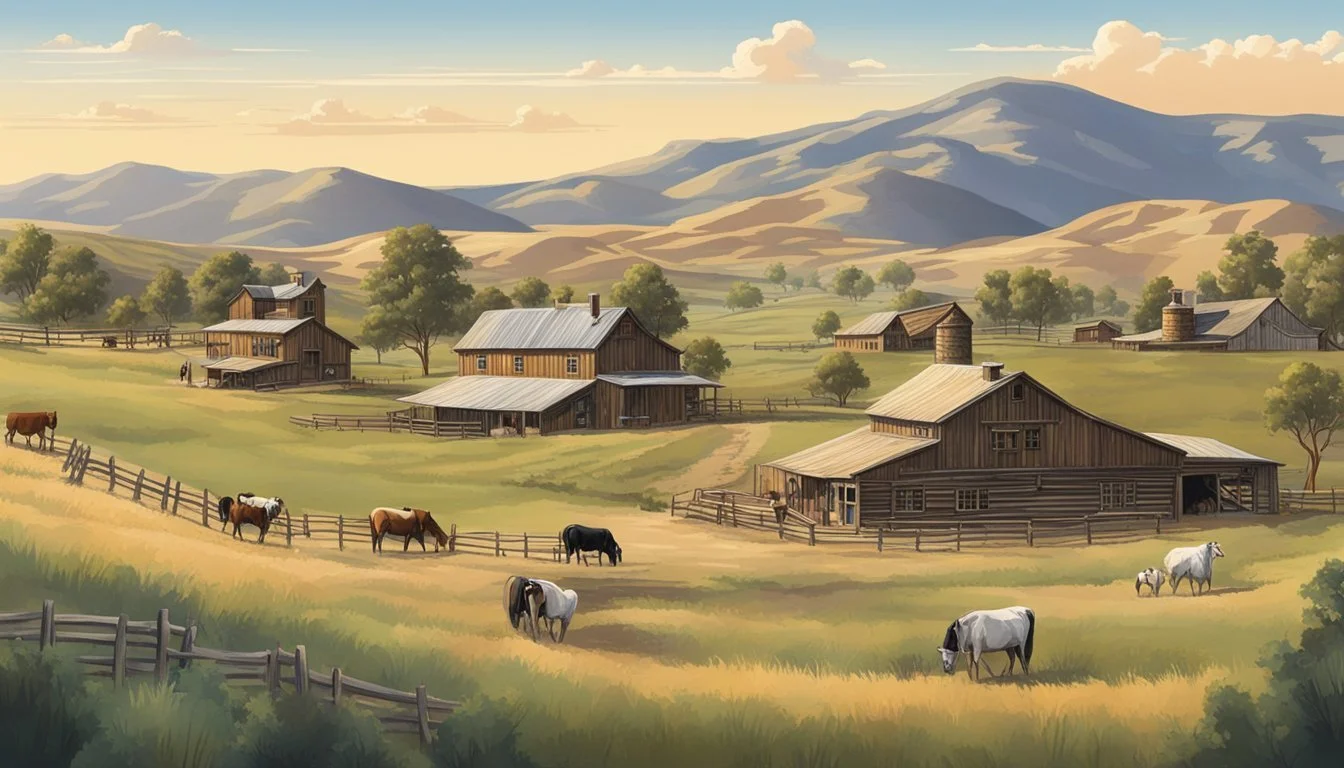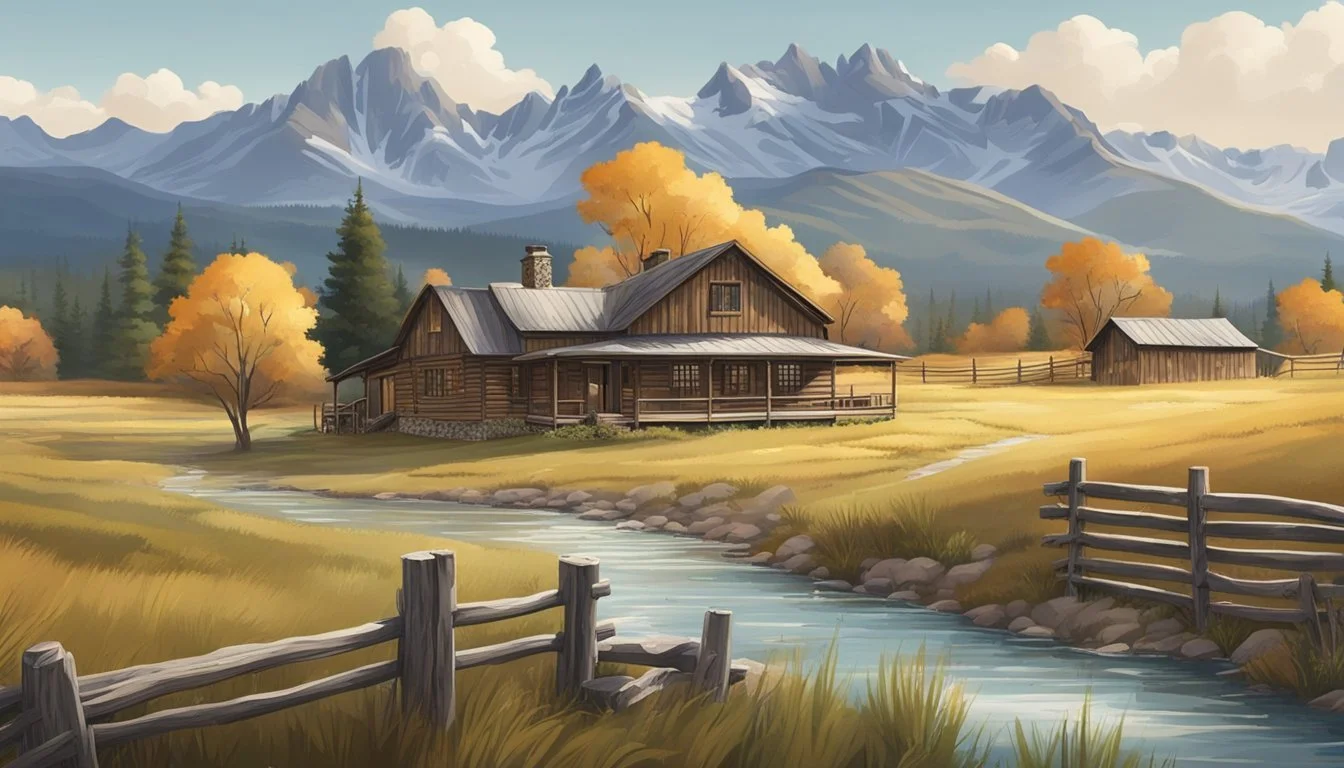Set Design in Yellowstone: Bringing the Dutton Ranch to Life
Crafting Authenticity on Screen
The hit TV series Yellowstone captivates viewers with its stunning portrayal of the Dutton Ranch. Set against the breathtaking backdrop of Montana's rugged landscape, the show's production design team faces the challenge of bringing this iconic setting to life on screen.
The Yellowstone Ranch's authentic ambiance is achieved through a combination of real locations, meticulous set design, and carefully integrated visual effects. Exterior shots are filmed at the Chief Joseph Ranch, capturing the natural beauty of the Montana wilderness. This blend of reality and crafted elements creates a seamless and immersive experience for viewers.
At the heart of the show's visual appeal is the Dutton family lodge. Its design aesthetic reflects the rich history and character of a multi-generational ranching dynasty. The production team's attention to detail extends from the grand architectural features to the smallest decorative elements, each carefully chosen to tell the story of the Dutton family and their deep connection to the land.
History and Significance of the Dutton Ranch
The Dutton Ranch, a cornerstone of the hit series Yellowstone, draws inspiration from real-world locations and historical events. Its portrayal reflects the complex history of land ownership and cultural tensions in the American West.
The Inspiration Behind the Dutton Family's Saga
The Dutton family's story mirrors the experiences of many ranching dynasties in Montana. Their struggles to maintain control of their vast property echo real-life conflicts between landowners, developers, and indigenous tribes. Creator Taylor Sheridan drew from his own experiences and observations of modern ranching life to craft the Duttons' narrative.
The fictional ranch serves as a symbol of the changing American West, where traditional ways of life clash with modern pressures. This tension forms the core of the Duttons' ongoing battles to preserve their legacy.
The Transformation of Chief Joseph Ranch
The real-life Chief Joseph Ranch in Darby, Montana, serves as the filming location for the Dutton Ranch. Built in the early 1900s, this working cattle ranch has a rich history of its own. Its transformation into the iconic Yellowstone set involved careful preservation of its authentic features while adapting it for filming needs.
The ranch's lodge and barns retain their original charm, providing a genuine backdrop for the series. This blend of reality and fiction enhances the show's authenticity, allowing viewers to immerse themselves in the world of the Duttons.
Historical Context: 1923 and Nez Perce Tribe
The prequel series 1923 delves deeper into the Dutton family's history, exploring their roots in early 20th century Montana. This era was marked by significant challenges for ranchers, including economic hardships and conflicts over land rights.
The ranch's name pays homage to Chief Joseph of the Nez Perce tribe, highlighting the complex relationships between settlers and Native Americans. The Nez Perce's forced relocation in the late 19th century forms a crucial part of the region's history, influencing land ownership patterns and cultural dynamics that persist to this day.
The Setting and Geography of Yellowstone
Yellowstone's breathtaking landscapes serve as a crucial character in the show. Montana's rugged terrain and vast open spaces provide the perfect backdrop for the Dutton family's ranch empire.
General Topography and Montana's Essence
Montana's diverse topography plays a starring role in Yellowstone. Rolling prairies stretch as far as the eye can see, punctuated by towering mountains and deep valleys. Crystal-clear rivers snake through the landscape, vital lifelines for ranchers and wildlife alike.
The state's natural beauty is on full display, with snow-capped peaks, dense forests, and golden wheat fields. This varied terrain creates a stunning visual palette for the show's cinematographers to capture.
Montana's famous big sky dominates many scenes, emphasizing the vastness of the Dutton's domain. The ever-changing weather adds drama and atmosphere to key moments in the series.
Exploring Bitterroot Valley and Darby, Montana
Bitterroot Valley, home to the real-life Chief Joseph Ranch that serves as the Yellowstone Dutton Ranch, is a picturesque region in western Montana. This 65-mile-long valley is flanked by the Bitterroot Mountains to the west and the Sapphire Mountains to the east.
Darby, a small town in the valley, embodies the rural Montana charm depicted in the show. With a population of just over 700, it represents the tight-knit communities that are central to the Yellowstone narrative.
The area's natural beauty, with its lush forests and winding rivers, provides an authentic setting for the ranch scenes. The Bitterroot Valley's working ranches and agricultural heritage lend credibility to the show's portrayal of modern ranching life.
Bringing Authenticity to Screen: Production Design
The production design of Yellowstone brings the Dutton Ranch to life through meticulous attention to detail and a commitment to authenticity. Key elements include the role of the production designer, the set decorator's vision, and the careful selection of natural materials.
The Role of the Production Designer
The production designer oversees the visual aesthetic of Yellowstone, ensuring consistency across all sets and locations. They work closely with the director and cinematographer to create a cohesive look that captures the essence of Montana ranch life.
Production designers research historical and contemporary ranch designs, incorporating elements that feel true to the Dutton family's legacy. They balance the need for visual appeal with practical considerations for filming, such as camera angles and lighting requirements.
Set Decorator's Vision: Making Fiction Feel Real
Set decorators on Yellowstone focus on creating lived-in spaces that reflect the characters' personalities and lifestyles. They source authentic props and furnishings, paying attention to small details that add depth to each scene.
A key aspect of their work is adding layers of history to the ranch. This might include placing worn cowboy hats with authentic sweat stains or selecting furniture with a weathered patina. These touches help viewers feel immersed in the world of the Duttons.
Selection and Use of Natural Materials
Natural materials play a crucial role in bringing authenticity to the Yellowstone sets. Wood, stone, and leather are prominently featured, reflecting the ranch's connection to the land.
Set designers incorporate locally sourced materials whenever possible, such as rough-hewn timber for structural elements and native stone for fireplaces. This approach not only enhances the visual authenticity but also ties the production to the local environment and craftsmanship of Montana.
Textiles like wool blankets and cowhide rugs add texture and warmth to interior spaces, further emphasizing the rustic ranch aesthetic. These carefully chosen materials help create a tactile, lived-in feel that resonates with viewers.
Dutton Ranch Structures and Aesthetics
The Dutton Ranch in Yellowstone showcases iconic Western architecture and design. Its structures blend rugged functionality with rustic charm, creating a visual representation of ranch life.
The Iconic Lodge and Its Architectural Features
The Dutton family lodge stands as the centerpiece of the ranch. Its exterior features natural stone and weathered wood, blending seamlessly with the Montana landscape. Large windows offer panoramic views of the surrounding mountains and pastures.
Inside, the lodge boasts a grand stone fireplace as its focal point. Vaulted ceilings with exposed wooden beams add to the spacious feel. The interior design incorporates a warm color palette of earthy tones, complemented by cowhide rugs and leather furnishings.
Antique ranch implements and family heirlooms decorate the walls, telling the story of the Duttons' legacy. The overall aesthetic balances rustic elements with refined touches, creating a space that's both comfortable and impressive.
Inside the Bunkhouse: Living Quarters of the Cowboys
The bunkhouse serves as home for the Yellowstone ranch hands. Its simple, functional design reflects the no-frills lifestyle of working cowboys. Rough-hewn wooden walls and basic furnishings create a practical living space.
Bunk beds line the walls, maximizing sleeping capacity. A common area features a worn leather couch and a small kitchen for shared meals. Personal touches like rodeo posters and cowboy gear add character to the space.
The bunkhouse's utilitarian design contrasts with the main lodge but maintains the ranch's overall rustic aesthetic. It embodies the camaraderie and hard work central to ranch life.
Depicting Ranch Life on Yellowstone
The Yellowstone series offers a vivid portrayal of modern ranch life, blending traditional cowboy culture with contemporary challenges. It showcases the daily operations, lifestyle, and cultural influences of a large cattle ranch in Montana.
Lifestyle and Culture of Modern Cowboys
Yellowstone depicts cowboys as hardworking individuals deeply connected to the land. John Dutton, played by Kevin Costner, embodies the stoic ranch patriarch. His character balances traditional values with the pressures of modern business.
The show highlights the cowboy code of loyalty, hard work, and respect for nature. Scenes of cattle drives, horse training, and campfire gatherings illustrate this lifestyle.
Cowboys on Yellowstone wear practical attire - boots, jeans, and cowboy hats. They demonstrate skills in horsemanship, roping, and animal husbandry.
Ranch Operations and Daily Activities
Yellowstone portrays the complex operations of a large cattle ranch. Scenes depict branding cattle, mending fences, and managing grazing lands.
The series showcases modern ranching technology alongside traditional methods. Characters use ATVs and computers while still relying on horses for many tasks.
Veterinary care, financial management, and land conservation are key aspects of ranch life shown in the series. The Dutton family deals with issues like water rights and property disputes.
The Influence of Yellowstone on Public Perception
Yellowstone has significantly impacted public understanding of modern ranch life. The show's popularity has increased interest in ranch tourism and Western culture.
The series highlights environmental and economic challenges facing ranchers today. It portrays conflicts between ranchers, developers, and conservationists.
Yellowstone's depiction of ranch life, while dramatized, has brought attention to the importance of preserving America's ranching heritage. The show's stunning cinematography showcases the beauty of Montana's landscapes, further enhancing public appreciation for ranch territories.
Behind the Scenes: Production Insights
The production team's meticulous attention to detail brings authenticity to the Dutton Ranch. Their craftsmanship and innovative approaches create an immersive world for viewers.
The Craftsmanship in Set Creation
Production designer Yvonne Boudreaux, who joined Yellowstone in season 2, leads the charge in crafting the show's iconic sets. Her team utilizes a mix of authentic ranch elements and custom-built pieces to achieve a realistic aesthetic.
Boudreaux emphasizes the importance of texture and patina in creating lived-in spaces. The team sources genuine antiques and weathered materials to add depth to the ranch interiors.
For exterior scenes, the production often films on location in Montana. This allows them to capture the breathtaking landscapes that are integral to the show's visual identity.
Exclusive Look at the Season Finale Set
The season finale set required extensive preparation and innovative solutions. The production team constructed a temporary structure on location to accommodate a pivotal scene.
Special effects and lighting played crucial roles in enhancing the dramatic atmosphere. The set designers worked closely with the cinematography department to ensure optimal camera angles and lighting setups.
Props and set dressing were carefully curated to reflect character development and storyline progression. Each item on set was chosen with purpose, adding layers of meaning to the visual narrative.
The Expansion of the Yellowstone Universe
The Yellowstone franchise continues to grow, with multiple spinoffs in various stages of development. These new series aim to explore different time periods and locations within the Dutton family saga.
Introduction to Spinoffs: 6666 and Others
Taylor Sheridan's Yellowstone universe is expanding rapidly. The spinoff 6666, set on the historic Four Sixes Ranch in Texas, is in the works. This series will showcase a different aspect of ranching life outside of Montana.
Two additional spinoffs, tentatively titled 1944 and 2024, are also in development. 1944 will likely explore the Dutton family's experiences during World War II. 2024 promises to offer a present-day perspective on the ranch and its inhabitants.
The successful prequel series 1883 and 1923 have already broadened the Yellowstone timeline. These shows have delved into the Dutton family's earlier generations and their struggles to establish and maintain their ranch.
As Yellowstone's main series concludes, these spinoffs ensure that fans will have plenty of new content to look forward to in the coming years.





